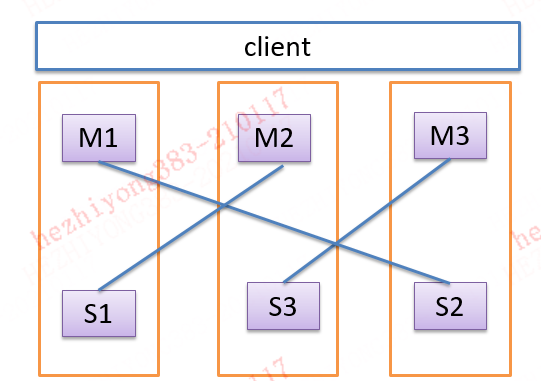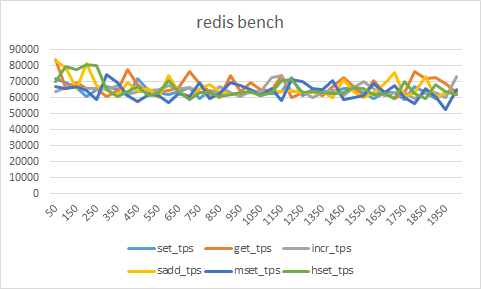测试工具:redis-benchmark
测试版本:redis cluster 5.0.7
测试架构:

基中m1,m2,m3 为三个独立机房
测试结果:

测试脚本:
#!/bin/bash
#CLIENTS=50 #defaul clients
HOST='192.168.1.1'
PORT=4000
PWD='benchtest' # if have passwod
end_clients=2000
CMDS="set"
cmd_arry=(set get incr sadd mset mget hset) #ad hoc test redis command
KEYSPACE=100000
TOTAL_REQUESTS=500000 #default 100000
data_size=100 #Data size of SET/GET value in bytes (default 3)
CURRENT_DATE=`date +%Y%m%d`
bench_file='redis-benchmark'-${CURRENT_DATE}
benchmark='/redis/base/bin/redis-benchmark'
benchmark(){
cmd=$1
for clients in `seq 50 50 $end_clients`;do
if [ x"$pipeline" != "x" ];then
with_pipeline="-P $pipeline"
fi
benchmark_cmd="$benchmark -h $HOST -p $PORT -c $clients $with_pipeline -r $KEYSPACE -n $TOTAL_REQUESTS -t $cmd -d $data_size"
echo "[info] `date +"%Y-%m-%d %H:%M:%S"` : $benchmark_cmd ">>benchmark_cmd.log
tps=`$benchmark_cmd | grep "requests per second" | awk '{print $1}'`
echo "$cmd,$clients,$data_size,$tps" | tee -a ${bench_file}_${cmd}.txt
done
}
for cmdelement in ${cmd_arry[@]};do
echo $cmdelement
benchmark $cmdelement #don't use pipline
done
测试结论:在value 为100byte 请求为500000 ,KEYSPACE 为100000的情况下,redis 的tps 为7w左右
参考:
http://www.redis.cn/topics/benchmarks.html
redis-benchmark 帮助文档:
Usage: redis-benchmark [-h <host>] [-p <port>] [-c <clients>] [-n <requests>] [-k <boolean>]
-h <hostname> Server hostname (default 127.0.0.1)
-p <port> Server port (default 6379)
-s <socket> Server socket (overrides host and port)
-a <password> Password for Redis Auth
-c <clients> Number of parallel connections (default 50)
-n <requests> Total number of requests (default 100000)
-d <size> Data size of SET/GET value in bytes (default 3)
--dbnum <db> SELECT the specified db number (default 0)
-k <boolean> 1=keep alive 0=reconnect (default 1)
-r <keyspacelen> Use random keys for SET/GET/INCR, random values for SADD
Using this option the benchmark will expand the string __rand_int__
inside an argument with a 12 digits number in the specified range
from 0 to keyspacelen-1. The substitution changes every time a command
is executed. Default tests use this to hit random keys in the
specified range.
-P <numreq> Pipeline <numreq> requests. Default 1 (no pipeline).
-e If server replies with errors, show them on stdout.
(no more than 1 error per second is displayed)
-q Quiet. Just show query/sec values
--csv Output in CSV format
-l Loop. Run the tests forever
-t <tests> Only run the comma separated list of tests. The test
names are the same as the ones produced as output.
-I Idle mode. Just open N idle connections and wait.
Examples:
Run the benchmark with the default configuration against 127.0.0.1:6379:
$ redis-benchmark
Use 20 parallel clients, for a total of 100k requests, against 192.168.1.1:
$ redis-benchmark -h 192.168.1.1 -p 6379 -n 100000 -c 20
Fill 127.0.0.1:6379 with about 1 million keys only using the SET test:
$ redis-benchmark -t set -n 1000000 -r 100000000
Benchmark 127.0.0.1:6379 for a few commands producing CSV output:
$ redis-benchmark -t ping,set,get -n 100000 --csv
Benchmark a specific command line:
$ redis-benchmark -r 10000 -n 10000 eval 'return redis.call("ping")' 0
Fill a list with 10000 random elements:
$ redis-benchmark -r 10000 -n 10000 lpush mylist __rand_int__
来源:oschina
链接:https://my.oschina.net/zhiyonghe/blog/4907109